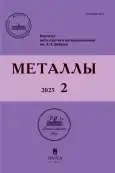Приведен материал по разработке способа получения твердофазных соединений (ТФС) лопаток с диском в деталях типа «блиски» (blades and disks), работающих в условиях воздействия высоких растягивающих, изгибных и термических напряжений (статических, повторно-статических, усталостных и др.). Качество ТФС зависит от таких факторов, как атмосфера (степень вакуума) в процессе сварки давлением (СД), уровень подготовки свариваемых плоскостей, температура, величина и длительность приложения давления при СД. Данная публикация (часть I) посвящена исследованию влияния степени вакуума в процессе СД на качество сварных соединений, которое оценивали по прочности на растяжение сварных образцов при комнатной температуре. Изучение влияния режимов проведения ТФС в условиях сверхпластичности только дискового сплава на строение и свойства сварных соединений показало, что образцы со специально подготовленной поверхностью, полученные в среде низкого вакуума при ТФС, демонстрируют прочность на растяжение, которую, по-видимому, можно считать достаточной для обеспечения длительной работы такой детали, как «блиск», в газотурбинных двигателях. Проведение СД в условиях повышенного вакуума позволило получить сварное соединение с прочностью при испытаниях на растяжение, превышающей таковую у наименее прочного при комнатной температуре свариваемого особожаропрочного сплава ВКНА-25 с монокристаллической структурой. Проведение после СД термической обработки (1200 °С / 6 ч + 950 °С / 6 ч), необходимой для формирования в дисковом сплаве крупнозернистой структуры и обеспечивающей его высокие характеристики жаропрочности, не влияет на механические свойства сварных соединений.
 1-1
1-1


 5-10
5-10


 11-23
11-23


 24-33
24-33


 34-40
34-40


 41-48
41-48


 49-56
49-56


 57-69
57-69


 70-76
70-76


 77-87
77-87


 88-96
88-96












